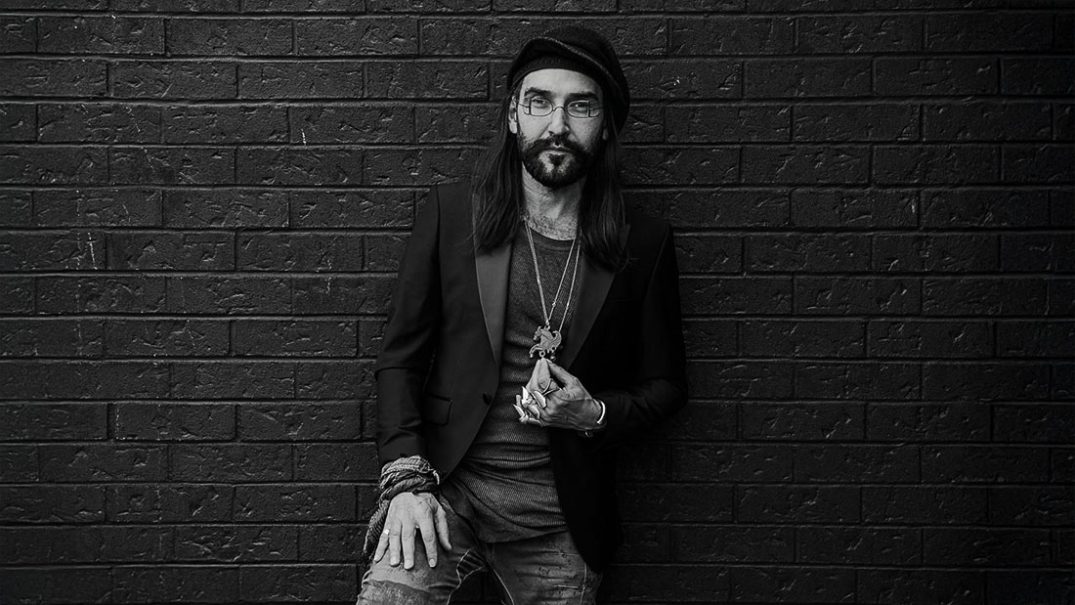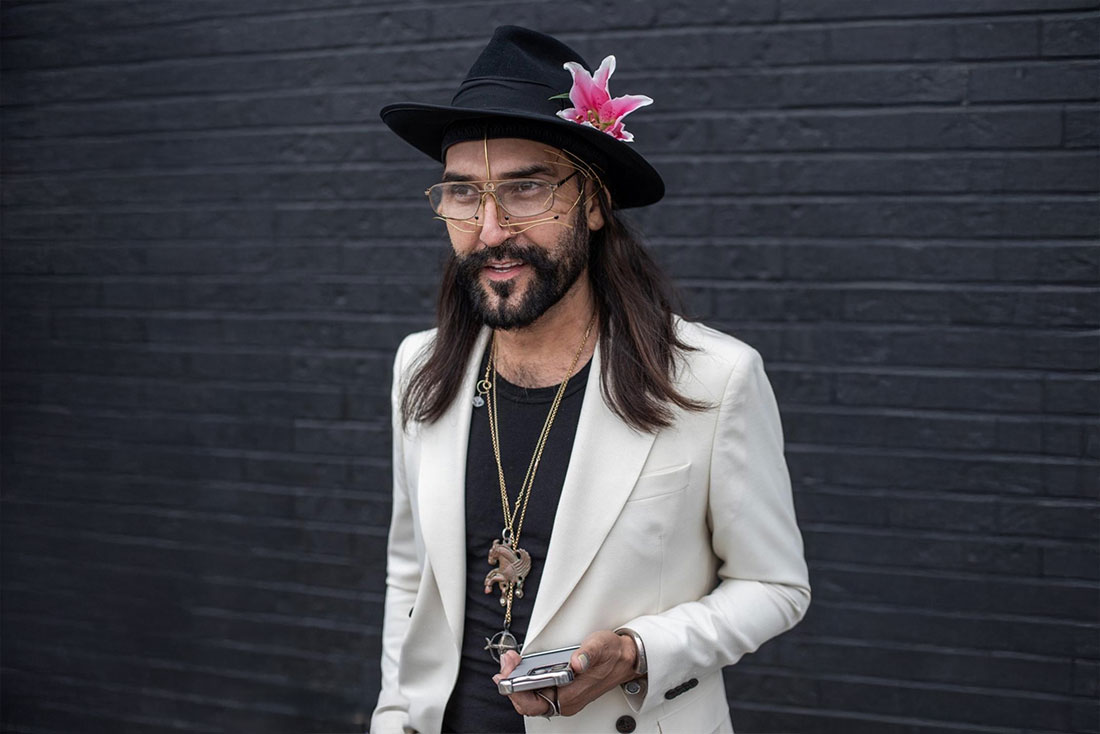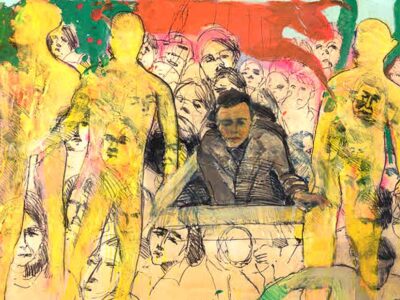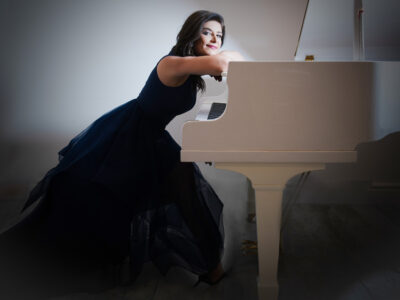Behzad Bolour | The Last Nomad of Persian Sound
If there’s ever been a voice that roamed across the deserts of exile, the alleyways of underground concerts, and the faded ruins of lost Persian empires—and brought them all into your headphones with a velvet force—it’s Behzad Bolour.

Born in 1965 in Tehran, Behzad was never just a journalist. From the moment he won Iran’s National High School Award in Fine Arts at 15, it was clear he was already carving his path—not through politics or power, but through the vibrating strings of a tar, the folds of a woolen hat from Sudan, and the pulse of a disappearing language.
By 1983, he had left Iran. What followed was a decades-long detour through design, graffiti, sound, and silence. In 1990, that detour found its resonance: BBC Persian. And what began as a flirtation with youth radio quickly evolved into a cult career. Behzad became the architect of Roz-e Haftom, Tarikh-e Bousseh, ZigZag Comics, and most famously, Bolour-e Banafsh—a show that didn’t just cover Persian music. It resurrected it.
For 33 years, Bolour wasn’t just a producer; he was a wanderer with a mic. He traveled to forgotten Tajik towns, Kurdish villages, and East L.A. garages—wherever a Persian voice echoed in exile. His interviews didn’t follow scripts. They followed scars. He made legends blush and unknown kids go viral. He celebrated Iranian artists in America, profiled immigrants in Georgia, and reintroduced generations to Yalda, Hafez, and the sound of longing.
But then came 2023. In a sudden and silent move, BBC Persian cut the name “Bolour” from its archive, as if deleting a track could erase a legacy. “They made it as if I never existed,” he said in a video, visibly shaken. But Bolour doesn’t need a channel to echo. He is the frequency.
Today, at 59, he continues to trace the veins of Persian culture beyond borders—be it in Afghan poetry, Azerbaijani rhythms, or Tehran’s indie rebellion. What drives him isn’t nostalgia. It’s curiosity.
And now, in Los Angeles—the echo chamber of global identities—Behzad Bolour joins the celebration of the Tirgan Festival, curated by The Dejh. Once again, he stands not on a stage, but among the people. Listening. Telling and tuning the unheard.
Because some voices were never meant to be archived, they were meant to live.

Behzad Bolour | Photo by Pixoosphoto
ZH: Your style is unmistakable: the hats, the layered fabrics, the ornaments that seem collected from forgotten altars of distant lands. Is there a story behind every piece you wear—or are you building a story just by wearing them?
It took me years of searching, thousands of miles of travel, and more money than I care to admit to arrive at this version of myself.
All began with my mum in the 60s—she had a thing for cleanliness and coordination, and she made sure we did too.”
Grandfather and relatives always brought me clothes as gifts & since I was born, for some strange reason, I had a hat on in every black & white picture!
After the ’79 revolution, we played hide and seek with the religious moral police, and since everything diverted to a unified, bland, characterless religious look for men, I moved to the opposite side.
Digging into our Persian history and finding that men before Islam were very ornamental with distinct hairstyles, I said to myself:
This is me—a flag that represents a 4-dimensional man: a man whose roots are BC but whose appearance is AD!
A look that has not been affected by obstacles and represents our mythology, romance, and Persian identity for today’s lifestyle.
ZH: You were born in Tehran in the mid-60s, and your early life intersected with revolution, transition, and exile. What did Iran mean to you before you left—and what does it mean now?
I am fortunate to have experienced and witnessed so much of our history in the making. During Shah’s time, I saw how Tehran changed gradually, the parties, the mixed schools, and the shortcomings it also had, and the revolution came! During the revolution I was 13 and remember reading very heavy political books, books that were forbidden during Shah time, also were exposed to so many pictures and flyers of the revolution, but shart after the regime change, it all turned Islamic, and I & my friends had an out in the spring of 1979 that we will revive Iran from its hidden roots cause the Iran they are pushing forward is against all that shaped us.
So from that day, I researched and started changing my looks, the way I speak, and the way I think, so I wouldn’t be polluted by the extremist ideology that was forced on us.
ZH: At just 15, you won Iran’s National High School Fine Arts Award. Do you remember the moment you realized art wasn’t just a passion, but a language you were born to speak?
I’m still surprised I won that award—honestly, I don’t know why! ☺
But from the moment I could hold a pencil, my parents would praise me for every line I drew.
My grandfather used to buy me American superhero comic books, and when I was eight, my father bought me a full encyclopedia of Renaissance art. So I had some pretty amazing masters to learn from—between Batman and Botticelli!
I’d draw visual stories, and paint for hours, and fine art just became the love of my life.
By 16, I was already doing illustrations for a cultural magazine.
After I ran away to the UK, I somehow got into art school without even taking a foundation course—one month into the term!
The head of the department saw my paintings and said, “You’re in.” So yeah… I guess it all paid off in the end.
ZH: From classical Persian music to underground rap, from Afghan folklore to Kurdish lullabies—you’ve moved across sounds the way some people move across borders. What draws you to these “edge cultures”?
“Deconstruction of Harry by Woody Allen” is the best title for my music life!
I was—and still am—looking for pure emotions, and untouched reactions of artists toward their surroundings.
Finding the lost Iran in all this variety of sounds!
I fell in love with traditional Persian music after the revolution, because classical Persian music became so exciting. After all, it had its roots in the 1970s, with the support of the monarchy and the brief political freedom that followed the revolution.
I started learning classical Persian instruments in the 1980s.
When I moved to London, I did many small gigs and was eventually signed by a music label called Touch!, which focused on edgy world music.
BBC Persian interviewed me for my album Mish (“The Ram”), and that’s how the doors of radio music production opened for me in 1989.
Back then, I was helping out with Mahtab’s music learning and supporting behind the scenes.
Eventually, I was offered slots to fill during holidays… and I had to make a choice: to play Persian pop or Western music professionally.
So gradually, I came to peace with it.
However, through the live music request programs I hosted, I got deeply involved with the secret culture of Iran in the ’90s.
I heard people’s dreams, their voices, their private thoughts… and that’s where underground music emerged.
It was nothing like the pop music from L.A.—it was raw, fresh, and limitless in its lyrics and style.
That’s when I realized: there was a parallel world forming among Iranian youth, and it needed a platform.
So I gave them one.
After transitioning into television, I tried to trace our shared cultural roots with other nations—and to celebrate the joy of this colorful variety, along with a clear and grounded vision of how love, grief, life, and change are navigated in countries that share our history—or that host us as emigrants.
ZH: You’ve often worked like a cultural archivist—wandering into remote corners of Tajikistan, Uzbekistan & even Georgia or Georgian suburbs. Do you feel like you’re collecting fragments of a forgotten empire? Are you curating a museum of memory, piece by piece?
Absolutely, my job & mission is to pull all the scattered fragments from all over the world—from libraries, museums, festivals, remote European villages, and books and lands—to find ourselves again since 1979.
I have been successful in reintroducing the truth about nations & countries that we have mutual roots and history with, back to our minds, giving a sense of reality to oppose our fake pride that has been built up by a false understanding of history and imported culture.
Especially now that our identity is being attacked by Iran’s Islamic government and the Z generation, who are totally rejecting whatever is left of Iranian culture.
ZH: When you sit across from a musician—famous or not—you have a very particular energy. You don’t interview them. You draw them out. How did you develop this conversational style?
I have this thirst for honesty, for dropping the mask of pretense, and the only way to make the interviewee—or even the story—be its true self was to be one myself.
From day one, I tried to copy my own tone of voice when speaking with a friend, tried to recognize my own nervous facial gestures, and see—when not comfortable—what my body language!
So gradually, I became myself, without stage fright. And after interviewing thousands of people, this behavior needs no effort, and I can immediately become very close and friendly with anyone, not with pretense, but with joy.
I am almost numb when meeting people.
And I learn the interviewee’s personality very quickly and base the style of an interview on their state of mind, the environment that we are in, while correcting their broken Persian language, so the conversation becomes timeless and placeless.
ZH: Many in broadcasting play the role of host. But you often become part of the story—immersing yourself in the music, the environment, the emotions. Was that intentional, or just inevitable?
As a teenager, I wanted to know so many answers to hundreds of questions that I had.
Dreamed of Christopher Columbus and the feeling he had when discovering America!
Did Michael Jackson really wear white gloves even at home!?
Why do Americans call one of their coins a Dime? Why does Batman wear his underwear over his trousers!?
And why is Persepolis in ruins, but mosques have golden domes or the most colorful appearance?
On every program, I answer all the questions that a teenager or an Iranian adult has, but no one has any answers.
The joy of discovery and teaching makes me one with the story.
Being a producer for the BBC opened many doors for me—I met scientists, artists, and personalities that a normal person can only read about!
So I need to deliver the joy and the knowledge they radiate back to my audience.
ZH: “Bolour-e Banafsh” wasn’t just a show—it was a cult ritual for a generation of Persian speakers. When you created it, did you know you were building a cultural mirror for the diaspora?
Yes, because I’ve always wanted to show people a four-dimensional world—not just the polished surface, but the hidden layers: the history behind the story, the raw self beneath the mask, and the invisible ways migration reshapes a person.
Also, in the beginning, I had various shows—“The Private Lives of Famous People,” “Food Programme,” “Travelogue,” “Investigative Documentaries,” “Music Magazine,” and “Live Reporting”… but the BBC cut almost all of them into a single weekly half-hour slot. So this half hour, “Bolour Banafsh,” was my only outlet to put all of it in one.
And so, this unique show, with a joyful and visually rich image, was gradually created.
ZH: After decades of storytelling across continents and formats, how do you now choose which voices to amplify—and which stories to let speak for themselves?
Whatever is not a byproduct of the spell of Insta-fame.
Voices that have something to say—the way they picture life and emotions outside the normal expectations. Simple. Honest.
It’s about showing me & you a different angle, a different interpretation that makes life easier or more colorful.
I am also a strong disqualifier of artists who create under the influence of drugs. To me, it’s like doping in sports or cheating at exams.
ZH: You’ve always championed new voices, from underground musicians in Iran to immigrant artists in exile. What qualities do you look for in someone before you decide their story must be heard?
My mission was to undo years of formulaic repetition and imitation in the performance and delivery of popular music.
I disregarded capital music (music from Tehran & L.A.) and went to small cities and suburbia to find talents who never had the chance to publish their work, no matter what age, or in what style.
Also, with stars, I did the opposite: I rearranged their songs and took away the music video image from their performance, making them humble again, to give the audience a different story to their songs and their presence.
I followed and recognized the freshest reflections of life and personal experience in unknown artists, and gave them the best stage and best facilities to shine.
Because no one heard my music when I was a teenager, dreaming that one day I’d be on a stage with thousands clapping for me…
So now, I make other people’s dreams come true.
In my last days, I completely put aside pop stars and went on discovering shepherds, hunters, fishermen, carpet weavers—with talents and family-inherited songs.
ZH: Western audiences often view Middle Eastern music as “traditional” or “exotic.” How do you challenge that framing—and how do you introduce complexity without translation getting in the way?
This is a job half done at the BBC.
Before I left, in the last few years, I tried to discover fusions that are edgy and revive the joyfulness and mastery of the traditional Bazm style—old-school, acoustic, live Persian music with a small band.
I also tried to revive and promote anyone who had reinvented instruments that no one uses anymore.
ZH: As someone who has moved between radio, television, live concerts, and visual storytelling, what does performance mean to you today?
It’s Messiah’s Last Supper, Cyrus’s victory over Babylon, it’s a Pahlevan breaking chains for the circle of watchers, it’s me at the age of 3 playing a toy guitar for a family party in the 60s, and it’s Elvis jumping up and down, a professor teaching the students— and me, giving people what they never had: a Persian host.
To give a stunning visual and easily felt emotional tunes back to society, and to the Western audience. But it’s still in the making.
ZH: If you could create a Museum of Lost Cultures, what three sounds or visual pieces would be the first to enter your archive?
First, the cubist rhythms of the Pashtun folk music of Afghanistan!
It is unbelievable—for it’s not faithful to any norm and keeps changing as it pleases.
Then, the Parthian guitar (ancient Iran) that I’ve been trying to revive and remake for the past ten years!
An instrument that evolved into the Western guitar, the Rubab, and the Persian Tar.
Also, the ancient harp of the Sumerians has somehow survived to this day in the Persian Gulf (in secret exorcisms) and parts of Africa.
And finally, the hexagonal drums of the witches of Yakutia—
a forgotten republic in today’s Russia.
ZH: The Tirgan Festival in Los Angeles, where you’re now participating, revives an almost forgotten Iranian tradition.
Why do you believe Tirgan matters—not just for Iranians, but for a global audience seeking deeper roots?
It’s about reclaiming a secular, national, and vividly joyful philosophy of life—a way of thinking that once belonged uniquely to us.
It’s about replacing Western and Islamic heroes with our own role models.
To remember how we once lived: in harmony with nature, with family, with neighbors, with other cultures—guided by our own sense of etiquette and ethics (what we call adab).
And to find a new place for ourselves in the global conversation, not as victims of history, but as bearers of alternative wisdom in facing the crises of modern life.
I want to bring back the practical beauty of our myths— to show how they can still teach us how to think, how to feel, and how to live.
ZH: Ancient sources celebrate Arash the Archer and the sky-angel Tishtrya, who fought drought and restored rain, symbols of renewal and boundary-making. As someone who travels with a cultural lantern, how do these mythical dimensions of Tirgan resonate with your personal mission of cultural reclamation?
I lived with the idea of the metamorphoses of Tishtar (Tishteriya) for years. About four years ago, I asked children to imagine and draw their three stages: first, the human youth, then the bull of wisdom, and finally, the flying horse of war and rain. I saw how powerful it was—not just for them, but for my own life. It became a tool for growth, a guide for those going through personal change, to remind them that it’s okay to transform and that in the end—like rain—your metamorphosis can nourish others.
I’m trying to create a new generation of Persian secular saints. With Arash, it’s been more difficult, because people have seen so much of the surface—just “a hero throwing an arrow to make peace”—that they’ve forgotten the depth of its philosophy. There’s so much more to learn from him: about sacrifice, about destiny, about drawing boundaries with dignity. Right now, I’m reimagining his story visually, “cleaning” the old image to create something like a doctrine.
I’m working on a three-dimensional Naqali (Persian coffeehouse storytelling), using Shahrad, a powerful new actor, with live singing and imagery, to make it timeless and alive again.
ZH: Tirgan’s rituals—splashing water (āb-pashi), rainbow bracelets, poetry recitations—embody both playfulness and sacred hope. In your eyes, what do these embodied acts teach us about resilience, joy, and collective memory?
They remind us of the great cost we paid to preserve them as joyful rituals, making us humble toward objects and actions that might seem simple or insignificant. They teach us that the true value lies in the meaning behind the ritual, not the ritual itself. The journey to rediscover that meaning restores a kind of pride we’ve lost—a pride that has too often been replaced by borrowed values that have nothing to do with our own way of thinking or living.
ZH: Some say you travel with a lantern—not to illuminate the past, but to recover what modernity erased. Through every trip, and every interview, you polish fragments of a shattered heritage and place them behind cultural glass for the world to see. Do you see yourself as a collector or a witness? A restorer—or a storyteller?
I am piecing together a beautiful and profound culture—one whose founders now live in our mythology and among our ruins. My mission is to revive the true essence of Persian culture and philosophy.
It’s like reconstructing a shattered artifact, piece by piece, to understand how it once was, how it was broken, and how we might design its next form.
Persian culture is a way of life—a source of color in today’s monochrome world. It offers solutions: how to live peacefully with nature, how to respect one another, and how to bring joy and meaning to others.
And through it, we learn what modernity adds to us—and what we, in turn, can add to modernity.
In collaboration with ZH media
Interview by Ali Shahrokhi
Photo by Pixoosphoto



